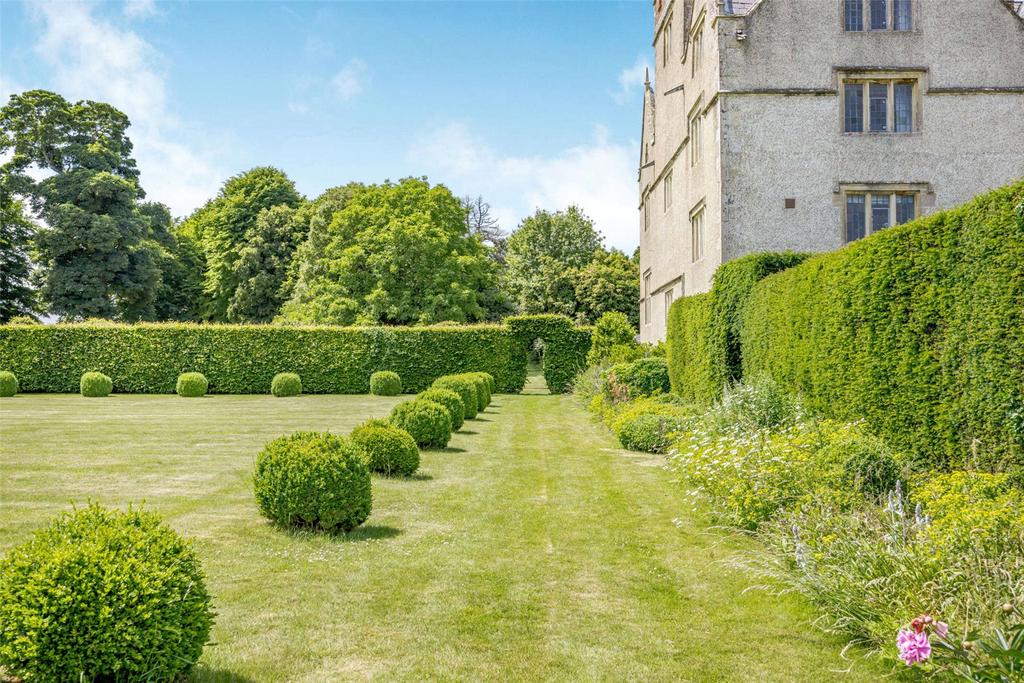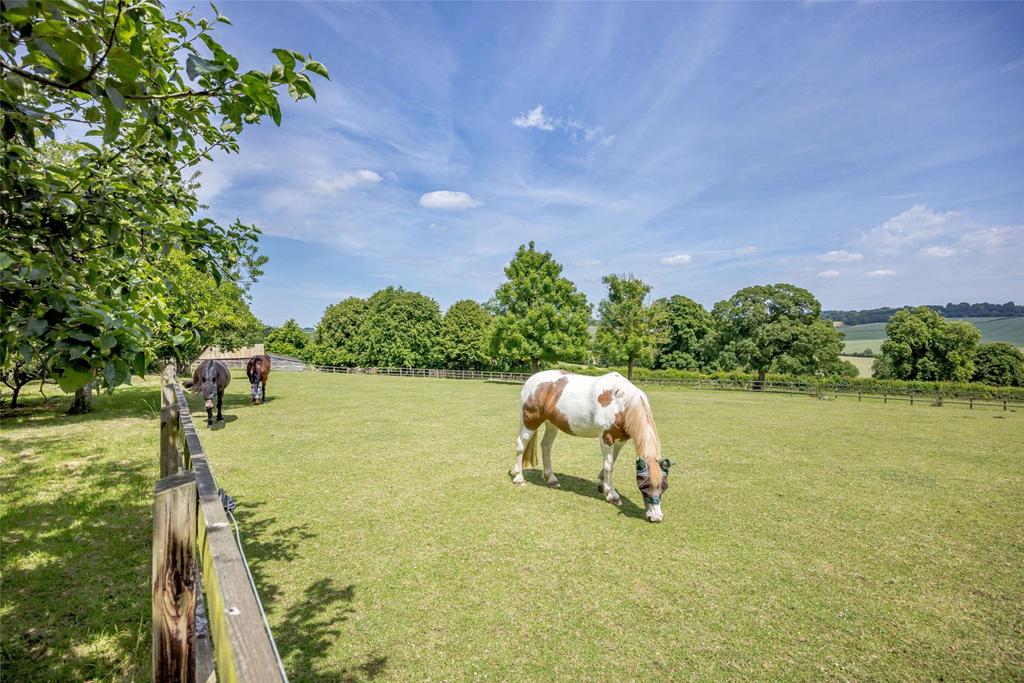No longer on the market
This property is no longer on the market
9 bedroom detached house
Premium display
Sold STC
Detached house
9 beds
7 baths
9.00 acre(s)
Key information
Tenure: Freehold
Service charge: £0 per annum
Council tax: Band TBC
Broadband: Ultra-fast 1000Mbps *
Mobile signal:
EEO2ThreeVodafone
Features and description
- Tenure: Freehold
- 10 Bedrooms
- 6 Reception Rooms
- Brick and Flint Barns
- Workshop
- Granary
- Stables
- Paddocks
- Wonderful views
Fawley Manor is an impressive Jacobean manor house set in an idyllic rural position in the North Wessex Downs’ Area of Outstanding Natural Beauty (AONB). The house is of historical interest and has been lovingly restored over the past 40 years. The manor is arranged over four floors around a stunning, original staircase which winds the full length of the house and offers the perfect mix of more formal and casual living areas. On the ground floor of particular note is the Old Hall which is a wonderful period piece room with an impressive 17th Century open fireplace, an original screens passage, oak panelling and large stone mullioned windows looking out across the formal gardens which can be directly accessed via double oak doors. On the floor above, there is an equally impressive reception room known as the Oak Room which is a magnificent oak panelled room approaching 30 feet in length with an open fireplace and commanding high level views over the Downs. The main core of the house is classical Jacobean and extends to approximately 6,000 sq ft. A substantial wing, believed to have been added in the 19th Century, amounts to approximately 4,000 sq ft, and is currently used as separate accommodation. This could be incorporated into the main house if desired.
The gardens and grounds at Fawley Manor are mature and have been cleverly designed with the history of the house in mind. There is a focus on strong geometrical topiary and avenues of evergreen trees. Close to the house are formal box parterres, again inspired by the Jacobean period. The house is approached via a sweeping driveway punctuated by mature beech topiary domes, culminating in a charming cobbled courtyard in front of the house. There is an old tennis court, a pond, an old orchard and a cutting garden. Beyond the formal gardens is a strip of woodland covered in snowdrops in the Winter and bluebells in Spring.
There is a row of brick and flint outbuildings, of which the Little Barn has plumbing and electricity and could be used as a separate cottage subject to the necessary planning consents. There is also a substantial run of stables which complements the pony paddocks next to the formal gardens.
Fawley Manor is situated in an elevated position within the hamlet of South Fawley. The neighbouring village of North Fawley has a beautiful church and an active local community. The larger village of Great Shefford which is also in easy reach, has a village shop with post office and a popular pub. There is a wealth of bridleways and byways for walking, horse riding and cycling across the Downs. The Ridgeway, an ancient track across particularly beautiful and remote high ridges and paths which pass by Age-old forts and barrows with figures of horses cut into chalk, is less than a couple of miles away. The nearby pretty market town of Wantage has a weekly market, regular farmers’ market and a good range of shops including a Waitrose supermarket. There is also a library, museum, cafes and restaurants. Hungerford, another nearby market town noted for its many antique shops, also has a wide choice of excellent facilities. Newbury and Oxford cater for most other shopping and entertainments. Communications in the area are excellent, with a fast train service from Didcot or Newbury into London Paddington, and easy access to the M4 and A34 linking easily to London, Heathrow Airport and the West Country. There is a wide choice of highly regarded schools in the area including Cothill, Pinewood, Bradfield College, Radley College, Abingdon, St Edwards, Marlborough College and Downe House.
Fawley Manor has a long and rich history dating back to the reign of King Edward the Confessor in the 11th century and sits on the same site as the previous manor house, South Fawley Manor. South Fawley Manor survived the Norman Conquest in 1066 and remained as a royal manor until 1594 when it was sold to Francis Moore. Moore was the son of a yeoman from East Ilsley who made his fortune as a barrister and was knighted in 1616. He served as MP for Reading in the late 16th and early 17th century. Francis Moore is credited with building the present manor house in 1614 and lived there until his death in 1621. The Moore family were staunch royalists, and following the Battle of Newbury in 1644 during the English Civil Wars, troops of the King’s Life Guards were quartered at the Manor house. In the 19th century the famous novelist Thomas Hardy is said to have visited Fawley Manor which inspired the writing of his novel, Jude the Obscure, and Hardy gave Jude the surname Fawley and the village of North Fawley he called Marygreen.
The gardens and grounds at Fawley Manor are mature and have been cleverly designed with the history of the house in mind. There is a focus on strong geometrical topiary and avenues of evergreen trees. Close to the house are formal box parterres, again inspired by the Jacobean period. The house is approached via a sweeping driveway punctuated by mature beech topiary domes, culminating in a charming cobbled courtyard in front of the house. There is an old tennis court, a pond, an old orchard and a cutting garden. Beyond the formal gardens is a strip of woodland covered in snowdrops in the Winter and bluebells in Spring.
There is a row of brick and flint outbuildings, of which the Little Barn has plumbing and electricity and could be used as a separate cottage subject to the necessary planning consents. There is also a substantial run of stables which complements the pony paddocks next to the formal gardens.
Fawley Manor is situated in an elevated position within the hamlet of South Fawley. The neighbouring village of North Fawley has a beautiful church and an active local community. The larger village of Great Shefford which is also in easy reach, has a village shop with post office and a popular pub. There is a wealth of bridleways and byways for walking, horse riding and cycling across the Downs. The Ridgeway, an ancient track across particularly beautiful and remote high ridges and paths which pass by Age-old forts and barrows with figures of horses cut into chalk, is less than a couple of miles away. The nearby pretty market town of Wantage has a weekly market, regular farmers’ market and a good range of shops including a Waitrose supermarket. There is also a library, museum, cafes and restaurants. Hungerford, another nearby market town noted for its many antique shops, also has a wide choice of excellent facilities. Newbury and Oxford cater for most other shopping and entertainments. Communications in the area are excellent, with a fast train service from Didcot or Newbury into London Paddington, and easy access to the M4 and A34 linking easily to London, Heathrow Airport and the West Country. There is a wide choice of highly regarded schools in the area including Cothill, Pinewood, Bradfield College, Radley College, Abingdon, St Edwards, Marlborough College and Downe House.
Fawley Manor has a long and rich history dating back to the reign of King Edward the Confessor in the 11th century and sits on the same site as the previous manor house, South Fawley Manor. South Fawley Manor survived the Norman Conquest in 1066 and remained as a royal manor until 1594 when it was sold to Francis Moore. Moore was the son of a yeoman from East Ilsley who made his fortune as a barrister and was knighted in 1616. He served as MP for Reading in the late 16th and early 17th century. Francis Moore is credited with building the present manor house in 1614 and lived there until his death in 1621. The Moore family were staunch royalists, and following the Battle of Newbury in 1644 during the English Civil Wars, troops of the King’s Life Guards were quartered at the Manor house. In the 19th century the famous novelist Thomas Hardy is said to have visited Fawley Manor which inspired the writing of his novel, Jude the Obscure, and Hardy gave Jude the surname Fawley and the village of North Fawley he called Marygreen.
Property information from this agent
About this agent

One of the UK’s leading agents in selling, buying and letting town and country houses and cottages, London houses and flats, new homes, farms and estates and residential development land around the country with expert local knowledge backed up by national expertise to ensure a quality service. With a network of over 50 offices nationwide, and 11 offices in Central London, plus our international reach through our memberships with Leading Real Estate Companies of the World® and Luxury Portfolio International, we are well placed to handle any property requirement.























